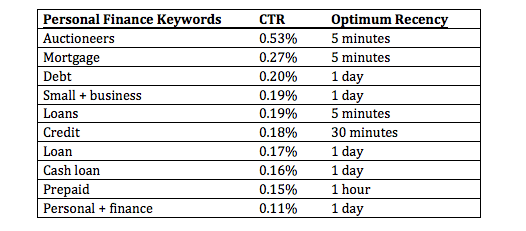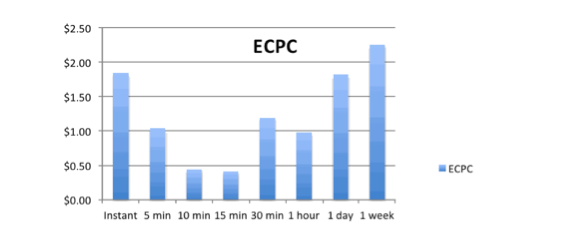Time Means Everything In Programmatic Display
Data is so often discussed and so very misunderstood! Data is nothing more than values of qualitative or quantitative variables. It turns out that the term [Data] is as generic as the term [Food]. There are all kinds of food, food groups, and food ingredient combinations. You see, data is the lowest level of abstraction. […]
Data is so often discussed and so very misunderstood! Data is nothing more than values of qualitative or quantitative variables. It turns out that the term [Data] is as generic as the term [Food]. There are all kinds of food, food groups, and food ingredient combinations.
You see, data is the lowest level of abstraction. On its own, Data carries no real meaning. Data viewed in context then produces information. Information tested and interpreted then results in knowledge.
Experimental Data
In online advertising, there is a potential treasure trove of audience data. The lowest level of known variables that are then mixed and matched determine one of two things:
Individual Intent: The specific purpose for why an individual would perform a certain act or series or acts. A prediction of what result or end an individual is seeking. Common examples, among hundreds, include keywords searched, websites visited and content read.
Individual Interest: A predication of how thoughts, beliefs, feelings and perceptions influence how people buy and relate to goods and services. In marketing, common variables, among thousands used to predict interest,can include gender, geography, income, race, age and much more.
When viewed in this context, audience data can be properly defined as “Experimental Data.” Experimental data is data generated within the context of a scientific investigation by observation and recording. This is the fuel that drives Programmatic or algorithmic auto optimization models popular among demand-side platforms and many alternative display channels.
Group Data Segments = Information Loss
I have noted in prior articles, and it is common knowledge among online advertising professionals, that the vast majority of display platforms in practice today are not in the data collection business. They are in the data consumption business. They purchase pre-packaged interest or intent “Audience Segments.” This is done for a fee, of course, and the bigger the audience in the segment, the more the data brokers can profit. Are you concerned yet?
A common segment, for example, would be “Cruise Intenders.” This may be an audience segment of 3 million unique individuals currently open to or actively seeking to go on a cruise. The probable data in this group segment could include a spectrum of data elements from individuals who have searched on cruise specific keywords or visited travel websites, to individuals of a certain age and income. These individual consumers are hardly equal in the level of their interest or intent.
Enter the display platforms with machine learning. “Machine learning” and “Patent Pending Algorithms” are phrases we are all force-fed. In reality, most of these companies have only automated the dated practice of ignoring the individual audience variables and optimizing the traditional group segments such as: Which sites should be blacklisted from this group? At what times of day are this group converting best? What ad frequency is ideal for this group?
There is a significant loss of valuable information when data is packaged into these groups. What individual behaviors are behind the highest converting and engaged consumers that are on the receiving end of your campaign? Imagine the knowledge and power that could be harnessed from programmatic media buying if you could see and control every data variable as if it were its very own segment!
The Most Valuable Data Variable In Advertising
In an effort to see if we can reach the same conclusion, I will begin with a short quiz for your testing pleasure:
Which cake is likely to taste best?
A) A cake baked just minutes ago
B) A cake baked 8 days ago
C) A cake baked 3 weeks ago
D) A cake whose baked date is a complete mystery
You are a car dealer with the world’s greatest sales force. A family of four is in desperate need of a new vehicle, and they walk onto your lot. Your odds of securing their business are best when:
A) The family is currently on your lot
B) The family left your lot 24 hours ago
C) The family left your lot 2 weeks ago
D) You have no idea when they visited your lot
You are a single location restaurant specializing in pizza. You want new customers to try your pizza. You select an advertising vendor who can serve ads to anyone who has searched on “pizza coupon” in your city. Which person is most likely to be influenced by your ad?
A) A consumer who performed the search 5 minutes ago
B) A consumer who performed the search 5 days ago
C) A consumer who performed the search 2 weeks ago.
D) A consumer who performed search in unknown 30-day window.
By now, you know the obvious truth is that the variable of “Time” can dramatically change the meaning behind any data element. In 90%+ scenarios it is the most recent data variable that contains the most predictable truth.
There are going to be dramatic differences between messaging to someone actively searching in the last 24 hours when compared to weeks ago. Alas, major brands and the agencies who support them continue to pour dollars into companies who can neither track nor bid differently for individual impressions within their group segment based on this information. All data within the segment are subjected to the same bid and same traditional optimization techniques.
Unstructured Data = Recency Insight & Control
At my company, Simpl.fi, we have found it critical to gather each data element behind every impression — What keyword was searched? What website was visited? What subject matter read? — rather than being limited by segments.
Alone, this is good information. Now, introduce the knowledge of when the search was performed and when the subject matter was consumed, combined with the ability to bid differently based on the recency of data. We have found that this level of insight and control is invaluable across direct response and branding campaigns leveraging programmatic media buying.
Here are some findings regarding “Data Recency” taken from more than 200 recent display campaigns for clients in the personal finance industry:
- We have found, for instance, that Click Through Rates (CTR) and conversion rates drop significantly once the data element used to opt the consumer into the campaign ages beyond 24 hours.
- The same data when examined at the lowest attribute level, in this case “keyword,” showed that optimum click and conversion rates vary dramatically based on if the search occurred within minutes vs. the last 24 hours:

- Another interesting finding is that when attempting to maximize conversions while achieving the best possible Costs Per Click (CPC), it is vital to know the recency of the data and to have a platform that can programmatically adjust bidding on highest converting elements and the age of the data. In the chart below, you can see how a sweet spot developed for achieving the best CPC between the aggressive bids tied to “Instant” recency and the diminishing clicks and conversions as the data signal ages

Summary
“Time is what we want most, but what we use worst.” ― William Penn
Time is precious, and never has this been truer than when attempting to string together data elements to predict the interest and intent of the audience you seeking to influence. We are moving into a new era of big data, when old rules around processing and grouping people into generalizations will reach their limitations quickly.
Unstructured data, vendor transparency and algorithm-driven platforms that can control the time variable at the smallest level will mean deeper insight and better performance.
Contributing authors are invited to create content for MarTech and are chosen for their expertise and contribution to the search community. Our contributors work under the oversight of the editorial staff and contributions are checked for quality and relevance to our readers. MarTech is owned by Semrush. Contributor was not asked to make any direct or indirect mentions of Semrush. The opinions they express are their own.
Related stories